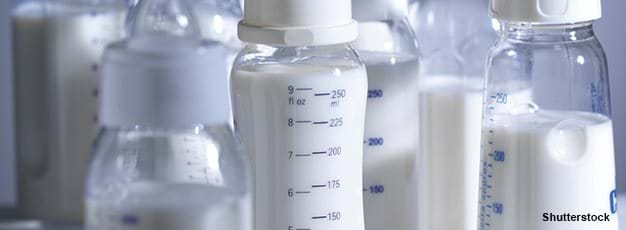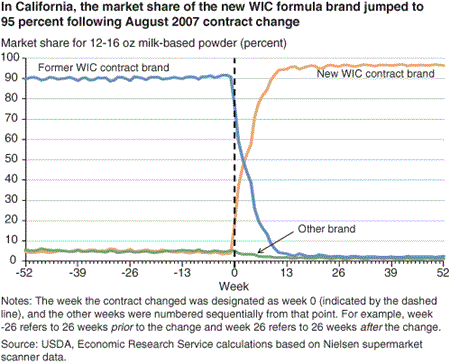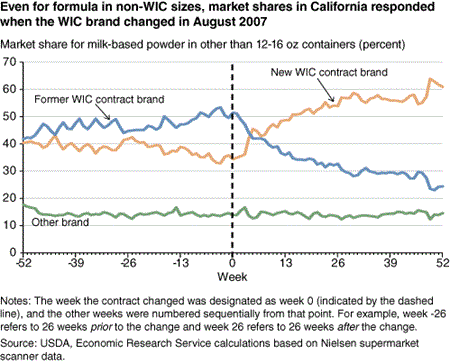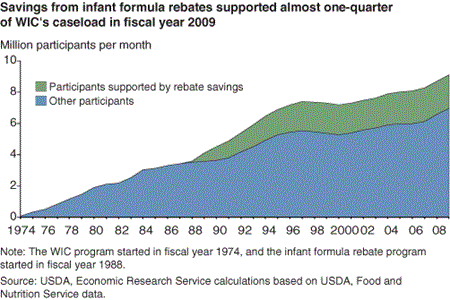Winner Takes (Almost) All: How WIC Affects the Infant Formula Market

Highlights:
-
ERS estimates that 57-68 percent of all infant formula sold in the United States in 2004-06 was purchased through WIC.
-
When a State switches its WIC contract to a different manufacturer, the market share of the new brand increases dramatically.
-
Most of the increase in market share is the direct effect of recipients purchasing the new WIC brand, but spillover effects also boost sales of the brand to non-WIC customers.
USDA's Special Supplemental Nutrition Program for Women, Infants, and Children--commonly known as WIC--is the largest purchaser of infant formula in the United States. Each State awards a sole-source contract to a formula manufacturer to provide its product to WIC participants. As a result, WIC participants can only redeem their WIC voucher for formula made by the manufacturer that holds the contract for that State.
In exchange for this exclusive sales arrangement, the manufacturer provides the WIC State agency with a rebate for each can of formula purchased through the program. The rebates are large. ERS estimated that among contracts in effect in December 2008, rebates averaged about 85 percent of the wholesale price (see box, 'Rebates Allow More People To Participate in WIC'). In other words, WIC paid only 15 percent of the wholesale price for formula. Why do formula manufacturers give WIC such large rebates? What are the impacts of sole-source contracts on infant formula manufacturers? A recent study by ERS researchers helps answer these questions.
Infant Formula Market Is Highly Concentrated
In 2008, three manufacturers accounted for almost 98 percent of all U.S. formula sales: Abbott, the manufacturer of Similac, had a 43-percent share of the market; Mead Johnson, maker of Enfamil, 40 percent; and Nestlé (now Gerber), maker of Good Start, 15 percent. Since the mid-1990s, these three firms have been the sole infant formula manufacturers awarded WIC contracts.
Almost two-thirds of all formula sales are at supermarkets and supercenters (mass merchandisers with full supermarkets). The remainder is sold in drug stores, convenience stores, mass merchandisers, warehouse clubs, online, and other outlets.
Infant formula comes in different forms (powder, liquid concentrate, and ready-to-feed), bases (milk, soy, and other), and container sizes. Milk-based formula in powder form is the primary type of formula purchased by both WIC and non-WIC consumers, accounting for 72 percent of all dollar sales. All milk-based powder formula purchased through WIC is sold in 12-16 oz containers. This formula type and container size accounts for about 55 percent of all formula sales. Milk-based powder in non-WIC size containers (smaller than 12 oz or larger than 16 oz) accounts for about 17 percent of all formula sales.
WIC Significantly Impacts the Infant Formula Market
ERS analysis of the infant formula market using 2004-09 scanner data from over 7,000 supermarkets in 30 States revealed that the WIC contract brands accounted for 92 percent of supermarket sales of milk-based powder formula in 12-16 oz containers by the three major manufacturers. WIC contract brands accounted for 51 percent of all sales of milk-based powder formula in non-WIC sizes.
Between January 2005 and April 2008, 30 States switched to a different manufacturer as exclusive provider of formula for the State's WIC participants. The switches provided 'before' and 'after' sales data, allowing a better understanding of the impact of WIC's sole-source contracts on infant formula sales in supermarkets.
ERS researchers compared each manufacturer's market share in a State in the 52 weeks prior to the contract change with its market share in weeks 13-52 after the contract change. Because WIC State agencies can issue food vouchers up to 3 months in advance, there is a transition period when WIC recipients switch to the new contract brand of formula. All WIC vouchers redeemed after about 12 weeks should reflect the new contract brand. As a result, weeks 0-12 were excluded to account for the transition period.
California--the State that serves the largest number of WIC infants--switched its WIC contract brand from Abbott to Mead Johnson in August 2007. The impact of this change on market shares of milk-based powder in 12-16 oz containers was dramatic. Abbott's market share in the State fell from about 90 percent in the year before the contract change to about 5 percent in the year after the change. On the other hand, Mead Johnson's market share increased from about 5 percent to about 95 percent.
ERS researchers found that the benefits of holding the WIC contract 'spill over' to non-WIC purchases. In California, Abbott's decline in market share for milk-based powder in non-WIC sizes was almost completely offset by Mead Johnson's increase in market share. Since all non-WIC sized containers are purchased outside of WIC, there is no transition period. Rather, after the contract changes, non-WIC sized containers saw a steady increase in market share for the new contract holder over time and a decrease in market share for the former contract brand.
ERS researchers found similar effects on market shares across the 30 States. For milk-based powder in 12-16 oz containers, the market share of the new WIC contract brand manufacturer increased by an average 84 percentage points across the 30 States. The market share of the former contract holder decreased by almost the same amount--83 percentage points--after losing the contract. The market share of the third manufacturer--the one that did not hold the WIC contract during either period--decreased by less than 1 percent.
As in California, manufacturers that won the WIC contract also saw increased spillover formula sales in non-WIC sized containers. In the 30-State analysis, the manufacturer that won the WIC contract experienced an average 18-percentage-point increase in market share of formula in non-WIC sizes, while the manufacturer that lost the contract experienced an average 19-percentage-point decrease in market share. The market share of the third manufacturer showed little change.
Spillover Effects Can Occur for a Variety of Reasons
The indirect effects from winning the WIC contract, namely increased sales of formula not purchased with WIC vouchers, are especially lucrative for manufacturers because they do not pay a rebate on formula purchased outside of WIC. As a result, manufacturers' revenues per can for non-WIC formula in 2008 were, on average, over six times greater than those for formula purchased through WIC.
A manufacturer of the WIC contract brand can realize spillover effects in non-WIC purchases in a number of ways. Since WIC infants account for a large portion of infant formula consumers, retailers will devote more shelf space and better product placement to the WIC contract brand, resulting in increased product visibility that may spur sales to non-WIC consumers. Furthermore, WIC-authorized stores are required to maintain a minimum stock of the WIC contract brand. Smaller grocery stores have limited shelf space and, as a result, may stock only one brand of formula--the WIC contract brand. Non-WIC patrons of these stores have limited options and may purchase the WIC contract brand rather than shop for a non-WIC brand at a different store.
Sales also may rise if physicians recommend the WIC contract brand to all formula-feeding patients to avoid having to differentiate between those enrolled and those not enrolled in WIC. Similarly, some hospitals may provide the WIC brand of formula to all new formula-feeding mothers so that WIC mothers will not have to switch formulas once they leave the hospital.
To the degree that the quantity of formula provided by WIC does not meet all of their infant's formula needs, mothers of WIC infants may be reluctant to introduce a different brand of formula to their infants, supplementing their WIC-provided formula by purchasing the same brand out of pocket. WIC recipients who are satisfied with the WIC contract brand of formula may recommend the brand to their non-WIC friends and relatives--another spillover scenario.
Results Explain Why Manufacturers Can Offer Large Rebates
There are several possible reasons for the sizeable rebates offered by the formula manufacturers. Winning the WIC contract assures large-volume sales to the manufacturer, including higher volumes of the more profitable non-WIC sales.
Formula manufacturers have large manufacturing plants, and operating these plants at less than the optimal level is inefficient, leading to higher per unit costs. Winning the WIC contract, especially for a larger State or a multistate alliance, can have a considerable impact on the manufacturer's ability to operate at or near optimal capacity.
Food and beverage manufacturers pay a variety of fees and payments to food retailers so they will carry their product. The formula manufacturer with the WIC contract has a stronger bargaining position, especially with regard to WIC-authorized stores. The manufacturer may be able to negotiate lower fees than the other formula manufacturers because of the large volume of sales associated with the WIC contract brand.
As a result, manufacturers that operate at less than optimal levels or that want to keep production levels high and face expiring contracts have an incentive to bid aggressively on new contracts. Furthermore, because formula volume sales have been decreasing over time, formula manufacturers are competing for a shrinking market, making winning WIC infant formula contracts even more important.
Rebates Allow More People To Participate in WIC
WIC serves low-income pregnant, postpartum, and breastfeeding women, infants, and children up to age 5 who are at nutritional risk. In fiscal year 2010, WIC served 9.2 million participants per month, including over half of all infants born in the United States. Federal program costs for WIC were $6.8 billion in fiscal year 2010.
In addition to nutrition education and referrals to health and other social services, WIC provides participants (or their caregivers) with vouchers, checks, or Electronic Benefit Transfer (EBT) cards to redeem at no cost for specific supplemental foods at nearly 49,000 authorized retail foodstores nationwide. Mothers participating in WIC are encouraged to breastfeed their infants if possible, but State WIC agencies provide formula (the equivalent of up to 31 cans of 13-oz cans of liquid concentrate per month) to mothers who choose to use it.
Each WIC State agency operates its own infant formula rebate program and is responsible for negotiating rebate contracts with infant formula manufacturers (some States form multistate alliances to enter into a single rebate agreement). As a result, the conditions of the contract--including the amount of the rebate, the contract term, and the manufacturer that holds the contract--will vary across States. These sole-source contracts are awarded on the basis of competitive bids: the firm offering the lowest net wholesale price (equal to the manufacturer's wholesale price minus the rebate) wins the WIC contract. WIC State agencies generally rebid their infant formula rebate contracts every 4 years. In many States, the manufacturer--and thus the brand of formula provided through WIC--changes from contract to contract.
WIC State agencies reimburse retailers the full retail price of the formula purchased with WIC vouchers. The WIC State agency then requests a rebate reimbursement from the manufacturer. As a result, the actual cost to WIC for each can of infant formula sold through the program is equal to the retail price minus the manufacturer's rebate.
Rebates are a major source of funds for WIC. In fiscal year 2009, WIC received $1.9 billion in rebates from infant formula manufacturers. Unlike entitlement programs, such as the Supplemental Nutrition Assistance Program (SNAP, formerly known as the Food Stamp Program), that guarantee assistance to all eligible applicants, WIC is a discretionary grant program funded annually by Congress that provides assistance to as many qualified applicants as funding allows. The savings generated by rebates provide benefits to additional participants within the same total budget. In recent years, rebates have supported almost a quarter of the WIC caseload.
The Infant Formula Market: Consequences of a Change in the WIC Contract Brand, by Victor Oliveira, Elizabeth Frazão, and David Smallwood, USDA, Economic Research Service, August 2011
Rising Infant Formula Costs to the WIC Program: Recent Trends in Rebates and Wholesale Prices, by Victor Oliveira, Elizabeth Frazão, and David Smallwood, USDA, Economic Research Service, February 2010
WIC Program, by Leslie Hodges and Jessica E. Todd, USDA, Economic Research Service, February 2024
The WIC Program: Background, Trends, and Economic Issues, 2009 Edition, by Victor Oliveira and Elizabeth Frazão, USDA, Economic Research Service, April 2009




